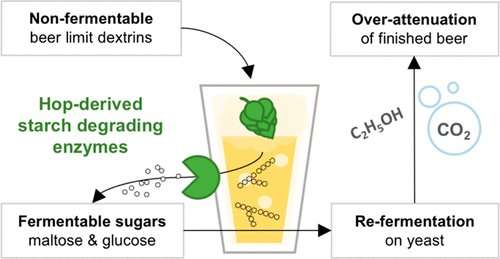Credit: American Chemical Society
The forgotten art of "dry-hopping" beer to enhance flavor is back in vogue. But this practice sometimes has undesirable side effects, such as an unexpectedly high alcohol content and high pressures that could cause beer bottles to break. Now, research published in ACS' Journal of Agricultural and Food Chemistry explains the biochemical basis of these unintended consequences, which could help brewers create "hoppy" beverages without the quality-control and safety issues.
During beer production, grain is mashed and steeped in hot water to convert starch into sugars. The liquid extract is then boiled with hop flowers to impart bitter flavor and a pleasant aroma and to limit bacterial contamination. Yeast is then added to ferment the sugars into alcohol. In dry-hopping, hops are added during or after the fermentation stage, meaning the resulting beer is less bitter. Although hops were previously thought to be inert ingredients, recent evidence suggests they contain biologically active compounds that restart the fermentation process and alter the final composition of beer. Thomas Shellhammer and Kaylyn Kirkpatrick wanted to identify the source of these changes.
The researchers dry-hopped a commercial beer and showed this boosted its carbon dioxide (CO2) and alcohol content, while lowering its carbohydrate content. They found that the activity of starch-degrading enzymes associated with hops—including amyloglucosidase, α-amylase, β-amylase and dextrinase—altered the composition of carbohydrates in the beer, shifting the balance to more fermentable sugars and thus increasing the alcohol content. The scientists also found that the amount of hops used, the duration and temperature of the process, and whether yeast was present affected the results. They say that brewers could use their findings to better control beer quality and safety when producing this trendy beverage.
More information: Kaylyn R. Kirkpatrick et al. Evidence of Dextrin Hydrolyzing Enzymes in Cascade Hops (Humulus lupulus), Journal of Agricultural and Food Chemistry (2018). DOI: 10.1021/acs.jafc.8b03563
Journal information: Journal of Agricultural and Food Chemistry
Provided by American Chemical Society
























